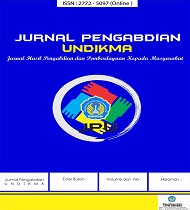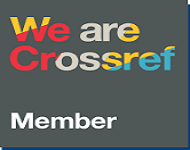Eduwall Android App Development Superapps-Based for Simplicity Learning for Deaf Students
DOI:
https://doi.org/10.33394/jk.v9i4.9057Keywords:
Android Apps, Eduwall, SuperApps, Learning, Disability, Deaf Students.Abstract
This research aims to develop an Android application called Eduwall based on the SuperApps framework for facilitating the learning process for deaf students. This study used a research and development (R&D) method, employing data collection techniques such as surveys, observations, interviews, and questionnaires to inform the development of the Eduwall application. The subjects in this research were deaf students at Pamulang University. The data analysis process encompassed six stages: concept development, design, material collection, assembly, product test and distribution. The research findings showed that the Eduwall application, based on the superapps model, was deemed suitable for use. This had been tested by IT experts, media experts, disability experts, lecturers, and students. The feasibility of this application means that the Eduwall application was practical, effective, efficient, and fun for students, especially deaf students. This Eduwall application was also equipped with a sign language dictionary to facilitate users in understanding the conditions of deaf students.
References
Afifah, et al. (2019). Effectiveness of Problem Based Learning and Problem Solving Towards the Critical Thinking Ability of Class V Students in Mathematics Learning. Journal of Mathematics Education, Science and Technology. Vol. 4, no. 1, (95-107).
Alfa Satyaputra Aritonang, EM (2014). Beginning Android Programming with ADT Bundle. Jakarta: PT. Elex Media Komputindo.
Arc C Luther. (1994). Authoring Interactive Multimedia. Boston : AP Professional.
Ariej, MC, & Rahardjo, T. (2019). Communication Adaptation of Deaf Students in Higher Education. Online Interaction, 8 No. 1, 132–144.
Ariesto Hadi Sutopo. (2013). Interactive Multimedia with Flash. Graha Ilmu: Yogyakarta.
Arifin, Zainal. (2012). Educational Research New Methods and Paradigms. Bandung: Rosda Karya Youth.
Arista, FC, & Kuswanto, H. (2018). Virtual physics laboratory application based on the Android smartphone to improve learning independence and conceptual understanding. International Journal of Instruction, 11(1), 1-16. Available at https://eric.ed.gov/?id=EJ1165233 .
Binanto, I. (2016). Digital Multimedia-Theoretical Basis and Development. Yogyakarta: Andi Offset.
Daryanto. (2013). Effective Learning Innovation. Bandung: Yrma Widya.
Ismail, et al. (2018). Learning Technology As Learning Media (Syarifuddi). Scholar Publisher.
Hasrul. (2010). Evaluation of the Grounding System for Domestic Electrical Installations in
Barru Regency. UNM : Electric Media
Herlandy, PB, & Novalia, M. (2019). Application of E-Learning in Network Communication Learning using the Blended Learning Method for Vocational School Students. Journal of Educational Informatic Technology and Science, Volume 1, 24–33. https://ejurnal.umri.ac.id/index.php/JeITS/article/view/1225 .
Husnul, NRI. (2021). Strategy Lecturer In E- Learning Management Improving Learning Outcomes Students at College High. Master of Management EducationFKIP Satya Wacana Christian University: manage Journal Educational Management. https://ejournal.uksw.edu/kelola/article/view/4357/1791.
Juanda, et al. (2018). Teachers' Expressive Speech Acts in Language Learning Indonesia Class X Student Man Pinrang. Education, 1(1), 11–24.
Karsidi, et al. (2013). Inclusive Education in Indonesia: Issues and Challenges. ASSAIHL International Conference 2013 in Colombo.
Kastubh A, J, Yogita H, K, Mayuri VM, Pooja G, N. (2017). Android Based ELearning Application "Class-E". International Research Journal of Engineering and Technology (IRJET) Volume 4 Issue 3 1745-1748.
Kemdikbud. (2021). Guide to organizing learning in 2018. academic year and 2020/2021 academic year during the pandemic. Coronavirus Disease 2019 (Covid-19) (Vol. 2019).
Kustandi and Sutjipto. (2013). Instructional Media; Manual and Digital. Bogor: Ghalia Indonesia.
Nakata, PA. (2003). Advance in Our Understanding of Calcium Oxalate Crystal Formation and Function in Plants. Plant Science. 164: 901-909.
Nazruddin Safaat H. (2012) (Revised Edition). Android Based Smartphone and Tablet PC Mobile Application Programming. Informatics. Bandung.
Ratini. (2011). Use of Interactive Multimedia to Increase Activities and Results Learning Biology for Muhammadiyah 1 Metro High School Students in the 2010/2011 Academic Year. Bio Education Journal of Biology Education, 2(1).
Safaat H, Nazruddin. (2015). Multiplatform Application Design. Informatics. Bandung.
Saripudin, S., Sumarto, S., Juanda, EA, Abdullah, AG, & Ana, A. (2018). Understanding technology literacy: The characteristics of ICT literacy vocational teachers. International Journal of Engineering and Technology (UAE), 7(4), 182-185.
Soleh, A. (2014). Accessibility of Persons with Disabilities to Higher Education. Case Study in Four Higher Education Institutions in Yogyakarta. Yogyakarta: LKIS Pelangi Aksara
Suryanto, A., Kusumawati, DA, & Sanhoury, IMH. (2018). Development of Augmented Reality Technology Based Learning Media of Lathe Machines. Journal of Technology and Vocational Education, 24(1), 32–38. https://doi.org/10.21831/jptk.v24i1.18245
Toto Ruhimat, et al. (2011). Curriculum and learning. Jakarta: Rajawali Press
Wang Qiyun & Cheung Wing Sum. (2003). Designing Hypermedia Learning Environments in Tan Seng Chee & Wong, Angela.FL (Eds.). Teaching and learning with technology: an Asian Pacific perspective (pages: 216-231). Singapore: Prentice Hall.
Downloads
Published
How to Cite
Issue
Section
Citation Check
License
License and Publishing Agreement
In submitting the manuscript to the journal, the authors certify that:
- They are authorized by their co-authors to enter into these arrangements.
- The work described has not been formally published before, except in the form of an abstract or as part of a published lecture, review, thesis, or overlay journal.
- That it is not under consideration for publication elsewhere,
- That its publication has been approved by all the author(s) and by the responsible authorities tacitly or explicitly of the institutes where the work has been carried out.
- They secure the right to reproduce any material that has already been published or copyrighted elsewhere.
- They agree to the following license and publishing agreement.
Copyright
Authors who publish with JK agree to the following terms:
- Authors retain copyright and grant the journal right of first publication with the work simultaneously licensed under a Creative Commons Attribution License (CC BY-SA 4.0) that allows others to share the work with an acknowledgment of the work's authorship and initial publication in this journal.
- Authors are able to enter into separate, additional contractual arrangements for the non-exclusive distribution of the journal's published version of the work (e.g., post it to an institutional repository or publish it in a book), with an acknowledgment of its initial publication in this journal.
- Authors are permitted and encouraged to post their work online (e.g., in institutional repositories or on their website) prior to and during the submission process, as it can lead to productive exchanges, as well as earlier and greater citation of published work.
Licensing for Data Publication
-
Open Data Commons Attribution License, http://www.opendatacommons.org/licenses/by/1.0/ (default)

This work is licensed under a Creative Commons Attribution-ShareAlike 4.0 International License.







